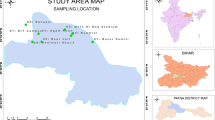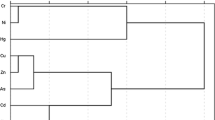Abstract
The water level fluctuation zone (WLFZ) in the Three Gorges Reservoir is located in the intersection of terrestrial and aquatic ecosystems, and assessing heavy metal pollution in the drown zone is critical for ecological remediation and water conservation. In this study, soils were collected in June and September 2009 in natural recovery area and revegetation area of the WLFZ, and geochemical approaches including geoaccumulation index (I geo) and factor analysis and soil microbial community structure were applied to assess the spatial variability and evaluate the influence of revegetation on metals in the WLFZ. Geochemical approaches demonstrated the moderate pollutant of Cd, the slight pollutant of Hg, and four types of pollutant sources including industrial and domestic wastewater, natural rock weathering, traffic exhaust, and crustal materials in the WLFZ. Our results also demonstrated significantly lower concentrations for elements of As, Cd, Pb, Zn, and Mn in the revegetation area. Moreover, soil microbial community structure failed to monitor the heavy metal pollution in such a relatively clean area. Our results suggest that revegetation plays an important role in controlling heavy metal pollution in the WLFZ of the Three Gorges Reservoir, China.



Similar content being viewed by others
References
Amaya, F. U., Cristina, L. M., Enrique, R., & Maria, L. F. M. (2009). Source identification of heavy metals in pastureland by multivariate analysis in NW Spain. Journal of Hazardous Materials, 165, 1008–1015.
Birth, G. (2003). A scheme for assessing human impacts on coastal aquatic environments using sediments. In C. D. Woodcoffe & R. A. Furness (Eds.), Coastal GIS 2003. Australia: Wollongong University Papers in Center for Maritime Policy.
Bu, H., Tan, X., Li, S., & Zhang, Q. (2010). Temporal and spatial variations of water quality in the Jingshui River of the South Qinling Mts., China. Ecotoxicology and Environmental Safety, 73, 907–913.
Censi, P., Spoto, S. E., Saino, F., Sprovieri, M., Mazzola, S., Nardone, G., Di Geronimo, S. I., Punturo, R., & Ottonello, D. (2006). Heavy metals in coastal water systems: A case study from the northwestern Gulf of Thailand. Chemosphere, 64, 1167–1176.
China National Environmental Monitoring Center. (1990). The background values of Chinese Soil. Beijing: China Environmental Science Press.
Demoling, L. A., & Baath, E. (2008). Use of pollution induced community tolerance of the bacterial community to detect phenol toxicity in soil. Environmental Toxicology and Chemistry, 27, 334–340.
Gargouri, D., Azri, C., Serbaji, M. M., Jedoui, Y., & Montacer, M. (2011). Heavy metal concentrations in the surface marine sediments of Sfax Coast, Tunisia. Environmental Monitoring and Assessment, 175, 519–530.
Helena, B., Pardo, R., Vega, M., Barrado, E., Fernandez, J. M., & Fernandez, L. (2000). Temporal evolution of groundwater composition in an alluvial aquifer (pisuerga river, Spain) by principal component analysis. Water Research, 34, 807–816.
Hinojosa, M. B., Carreira, J. A., García-Ruíz, R., & Dick, R. P. (2004). Soil moisture pre-treatment effects on enzyme activities as indicators of heavy metal-contaminated and reclaimed soils. Soil Biology and Biochemistry, 36, 1559–1568.
Idris, A. M. (2008). Combining multivariate analysis and geochemical approaches for assessing heavy metal level in sediments from Sudanese harbors along the Red Sea coast. Microchemical Journal, 90, 159–163.
Khan, S., Cao, Q., Zheng, Y. M., Huang, Y. Z., & Zhu, Y. G. (2008). Health risks of heavy metals in contaminated soils and food crops irrigated with wastewater in Beijing, China. Environmental Pollution, 152, 686–692.
Khan, S., Hesham, A. E. L., Qiao, M., Rehman, S., & He, J. Z. (2010). Effect of Cd and Pb on soil microbial community structure and activities. Environmental Science and Pollution Research, 17, 288–296.
Lasat, M. M. (2002). Phytoextraction of toxic metals: A review of biological mechanisms. Journal of Environmental Quality, 31, 109–120.
Lazzaro, A., Widmer, F., Sperisen, C., & Frey, B. (2008). Identification of dominant bacterial phylotypes in a cadmium-treated forest soil. FEMS Microbiology Ecology, 63, 143–155.
Li, L. L., Zhang, S., Liu, J. H., Zhao, X. L., & Gao, J. X. (2005). Investigation and evaluation on heavy metal pollution of water-level-fluctuating zone in Three Gorges Reservoir Area. Journal of Soil and Water Conservation, 19, 127–130 (in Chinese).
Li, L., Li, F. S., Xiong, D. Q., & Song, C. Y. (2006). Heavy metal contamination and their distribution in different size fractions of the surficial sediment of Haihe River, China. Environmental Geology, 50, 431–438.
Li, R. Z., Shu, K., Luo, Y. Y., & Shi, Y. (2010). Assessment of heavy metal pollution in estuarine surface sediments of Tangxi River in Chaohu lake basin. Chinese Geography Science, 20, 9–17.
Liao, M., & Xie, X. M. (2007). Effect of heavy metals on substrate utilization pattern, biomass, and activity of microbial communities in a reclaimed mining wasteland of red soil area. Ecotoxicology and Environmental Safety, 66, 217–223.
Liu, J. H. (1997). Preliminary study of Hg pollution in the city of Beijing. Research Centre for Eco-Environmental Sciences, Chinese Academy of Sciences (in Chinese): Beijing.
Loska, K., & Wiechuła, D. (2003). Application of principal component analysis for the estimation of source of heavy metal pollution in surface sediments from the Rybnik Reservoir. Chemosphere, 51, 723–733.
Lu, Z. J., Li, L. F., Jiang, M. X., Huang, H. D., & Bao, D. C. (2010). Can the soil seed bank contribute to revegetation of the drawdown zone in the Three Gorges Reservoir Region? Plant Ecology, 209, 153–165.
Ma, X. H., & Jiao, J. Y. (2005). Characteristics of vegetation with natural restoration in removal lands in loess hilly-gully region and the relationship between the characteristics and soil environment. Science of Soil and Water Conservation, 3, 15–22 (in Chinese).
Mays, P. A., & Edwards, G. S. (2001). Comparison of heavy metal accumulation in a natural wetland and constructed wetlands receiving acid mine drainage. Ecological Engineering, 16, 487–500.
Müller, G. (1969). Index of geoaccumulation in sediments of the Rhine River. GeoJournal, 2, 108–118.
Müller, G. (1981). Die Schwermmetallbelastung der sedimente des Neckars und seiner Nebenflusse: eine Bestandsaufnahme. Chemical Zeitung, 105, 157–164.
New, T., & Xie, Z. Q. (2008). Impact of large dams on riparian vegetation: Applying global experience to the case of China's Three Gorges Dam. Biodiversity and Conservation, 17, 3149–3163.
Qiao, S., Yang, Z., Pan, Y., & Guo, Z. (2007). Metals in suspended sediments from the Changjiang (Yangtze River) and Huanghe (Yellow River) to the sea and their comparison. Estuarine, Coastal and Shelf Science, 74, 539–548.
Renella, G., Mench, M., Landi, L., & Nannipieri, P. (2005). Microbial activity and hydrolase synthesis in long-term Cd-contaminated soils. Soil Biology and Biochemistry, 37, 133–139.
Rinklebe, J., & Langer, U. (2006). Microbial diversity in three floodplain soils at the Elbe River (Germany). Soil Biology and Biochemistry, 38, 2144–2151.
State Environmental Protection Administration of China. (1995). Environmental quality standard for soils (GB15618-1995). Beijing: China Environmental Science Press (in Chinese).
State Environmental Protection Administration of China. (2002). Water and waste water analysis (4th ed.). Beijing: Chinese Environmental Science Publish House (in Chinese).
State Environmental Protection Administration of China. (2009). Ecological and Environmental Monitoring Communique on the Three Gorges Project. Beijing: China Environmental Science Press (in Chinese).
Suhadolo, M., Schroll, R., Gattinger, A., Schloter, M., Munch, J. C., & Lestan, D. (2004). Effects of modified Pb-, Zn-, and Cd- availability on the microbial communities and on the degradation of isoproturon in a heavy metal contaminated soil. Soil Biology and Biochemistry, 36, 1943–1954.
Tang, J., Zhong, Y. P., & Wang, L. (2008). Background value of soil heavy metal in the Three Gorges Reservoir District. Chinese Journal of Eco-Agriculture, 16, 848–852 (in Chinese).
Wang, Q., Dai, J. L., Yu, Y., Zhang, Y. L., Shen, T. L., Liu, J. S., & Wang, R. Q. (2010). Efficiencies of different microbial parameters as indicator to assess slight metal pollutions in a farm field near a gold mining area. Environmental Monitoring and Assessment, 161, 495–508.
Ye, C., Li, S. Y., Zhang, Y. R., & Zhang, Q. F. (2011). Assessing soil heavy metal pollution in the water-level-fluctuation zone of the Three Gorges Reservoir, China. Journal of Hazardous Materials, 191, 366–372.
Yin, Y. J., Allen, H. E., Huang, C. P., & Sanders, P. F. (1997). Effects of pH, chloride and Calcium(II) on adsorption of monomethylmercury by soils. Environmetal Toxicology and Chemistry, 16, 2457–2462.
Yu, F., Zhang, C., Zhang, S., Wang, D. Y., & Huang, Y. P. (2006). Contents and distribution of heavy metals in the draw-down zone of the Three-Gorges Reservoir Area. Journal of Southwest Agricultural University (Natural Science), 28, 165–168.
Yu, R. L., Yuan, X., Zhao, Y. H., Hu, G. R., & Tu, X. L. (2008). Heavy metal pollution in intertidal sediments from Quanzhou Bay, China. Journal of Environmental Science, 20, 664–669.
Zhang, J., & Liu, C. L. (2002). Riverine composition and estuarine geochemistry of particulate metals in China―Weathering features, anthropogenic impact and chemical fluxes. Estuarine, Coastal and Shelf Science, 54, 1051–1070.
Zhang, M. Y., Cui, L. J., Sheng, L. X., & Wang, Y. F. (2009a). Distribution and enrichment of heavy metals among sediments, water body and plants in Hengshuihu wetland of Northern China. Ecological Engineering, 35, 563–569.
Zhang, W. G., Feng, H., Chang, J. N., Qu, J. G., Xie, H. X., & Yu, L. Z. (2009b). Heavy metal contamination in surface sediments of Yangtze River intertidal zone: An assessment from different indexes. Environmental Pollution, 157, 1533–1543.
Zhong, Z. C., & Qi, D. H. (2008). The illustrated species catalog and biodiversity in the hydro-fluctuation belt of Three Gorges Reservoir. Chongqing: Southwest China Normal University Press (in Chinese).
Acknowledgments
This research is supported by the Executive Office of the State Council Three Gorges Construction Committee (SX2008-005). We would like to thank Jing Wang, Wang Zhao, and Hailong Fang for their assistance during fieldwork, and Pingcai Yan for the assistance on the laboratory analyses. We also thank Professor G.B. Wiersma and anonymous reviewers for their constructive suggestions and comments on early draft of this manuscript.
Author information
Authors and Affiliations
Corresponding author
Rights and permissions
About this article
Cite this article
Ye, C., Li, S., Zhang, Y. et al. Assessing heavy metal pollution in the water level fluctuation zone of China’s Three Gorges Reservoir using geochemical and soil microbial approaches. Environ Monit Assess 185, 231–240 (2013). https://doi.org/10.1007/s10661-012-2547-7
Received:
Accepted:
Published:
Issue Date:
DOI: https://doi.org/10.1007/s10661-012-2547-7




